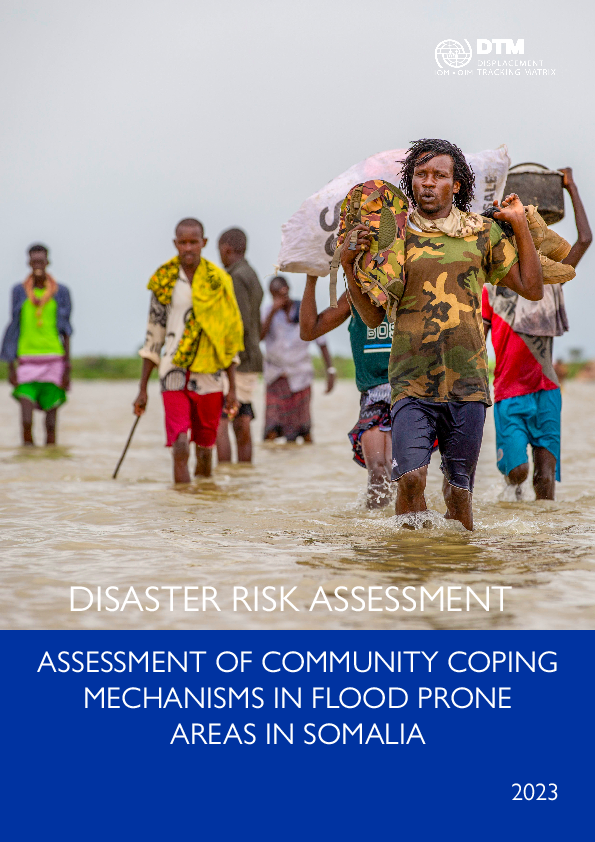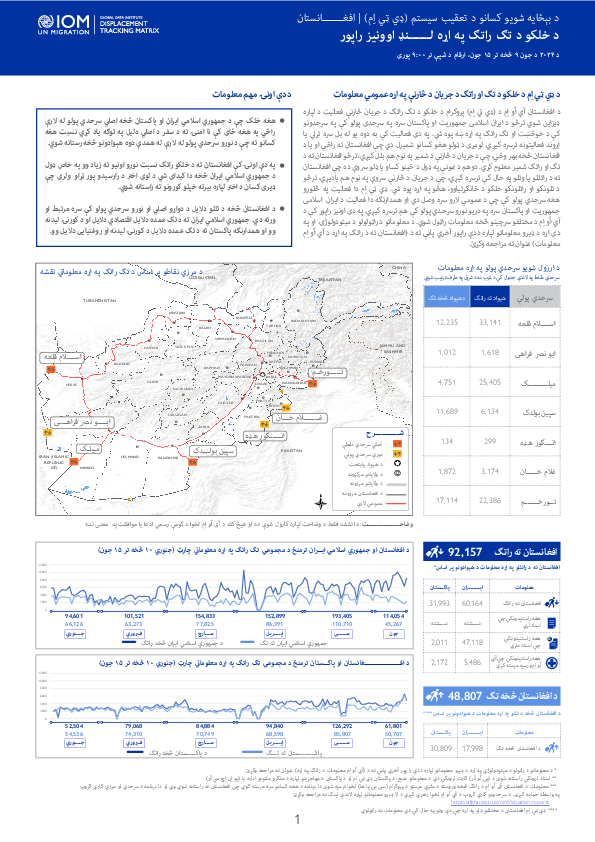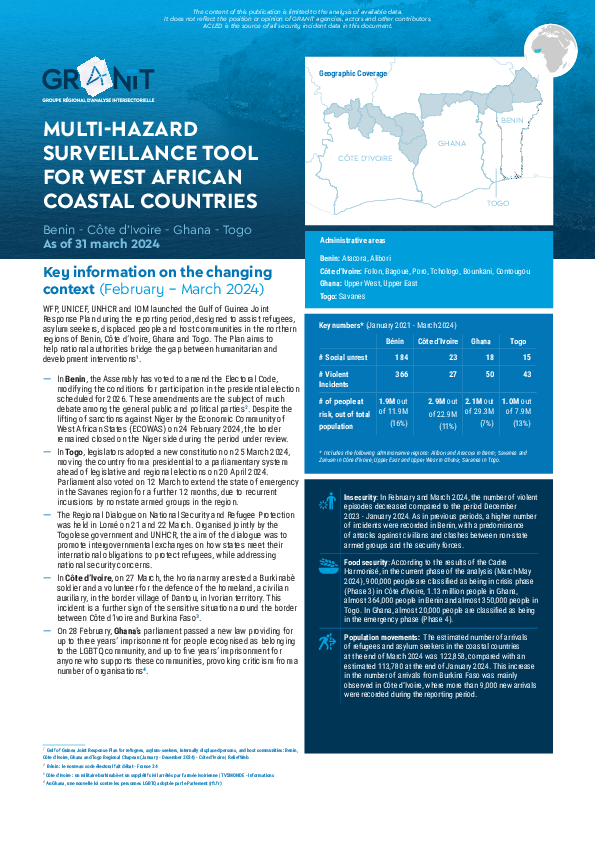-
Countries
-
Data and Analysis
-
Special Focus
-
Crisis Responses
Compilation/Overview
Color
white

Contact
DTMAfghanistan@iom.int
Language
English
Location
Afghanistan
Period Covered
Jun 16 2024
Jun 22 2024
Activity
- Survey
- Flow Monitoring Survey
- Flow Monitoring
The IOM Afghanistan’s DTM Flow Monitoring activity is designed to provide insights into the mobility patterns at Afghanistan’s border points with the Islamic Republic of Iran and Pakistan. The activity involves two interlinked exercises: the Flow Monitoring Counting (FMC), a headcount of individuals crossing the border, and the Flow Monitoring Surveys (FMS), which collect data on the profiles and intentions of randomly selected Afghan nationals. DTM FM is operational at four main crossing points (connected to Afghanistan’s National Highway) as well as five other crossing points with Islamic Republic of Iran and Pakistan. This weekly snapshot combines information from the FM activity and various IOM sources related to cross-border movement. For a detailed explanation of the methodology used in gathering this data, the report directs readers to the section titled “IOM INFLOW DATA” on the last page.

Contact
iraqdtm@iom.int
Language
English
Location
Iraq
Period Covered
Aug 01 2023
Aug 15 2023
Activity
- Other
- Survey
- Displacement Solutions
Following the release of the first edition of PROGRESS 2023 report, the Displacement Tracking Matrix (DTM) carried out focus group discussions to understand the nuances of the effects of displacement from the perspectives of individuals who were displaced, had returned or were part of communities which hosted IDPs. The focus group discussions served as a forum to share viewpoints that are not often captured by traditional data collection exercises, including affected communities' perceptions of cultural and gendered effects of displacement in their communities. The discussions were conducted in local languages and translated by IOM DTM staff.
The 2014 - 2017 conflict against the Islamic State in Iraq and the Levant (ISIL) displaced nearly 6 million Iraqis, with the Government of Iraq formally announcing the end of the conflict in December 2017. As of April 2024, 4,871,916 individuals returned from displacement to their areas of origin. However, 1,098,913 people still remain internally displaced more than six years after the end of the conflict. This report presents a deeper country-specific dive into the findings of the qualitative analysis of six focus group discussions conducted between 1 and 15 August 2023 in Kirkuk and Hawija districts (Kirkuk Governorate) and Makhmur district (Erbil Governorate) with 43 representatives of IDPs, host community and returnees from displacement linked to the 2014 - 2017 conflict. Just under half (47%) of the respondents were female. Nearly three quarters (72%) of respondents were between the age of 18 and 59, a further quarter (23%) were older than 60 years and 5 per cent were under the age of 17.

Contact
iraqdtm@iom.int
Language
English
Location
Iraq
Period Covered
Jan 01 2023
Dec 31 2023
Activity
- Survey
- Displacement Solutions
Following the release of the first edition of PROGRESS 2023 report, the Displacement Tracking Matrix (DTM) has compiled a series of National Displacement Profiles based on end of year 2023 figures. These profiles offer insights into the latest end-of-year 2023 figures, aligning with the objectives outlined by the Data for Solutions to Internal Displacement Taskforce (DSID).
The profile provides a comprehensive overview of the demographic breakdowns and geographical distribution of internally displaced persons (IDPs) in Iraq as of the end of 2023. It delves into the primary areas of origin and displacement for IDPs, shedding light on the factors influencing their decision-making processes regarding the selection of solutions locations. Additionally, the report discusses the obstacles encountered by IDPs in their pursuit of durable solutions.
This compilation underscores the critical role of data in addressing internal displacement challenges and highlights the ongoing efforts to leverage data-driven solutions through collaborative initiatives like DSID.

Contact
DTMCOLOMBIA@IOM.INT
Language
Spanish
Location
Colombia
Period Covered
Aug 01 2023
Aug 15 2023
Activity
- Other
- Survey
- Displacement Solutions
Following the release of the first edition of PROGRESS 2023 report, the Displacement Tracking Matrix (DTM) carried out focus group discussions to understand the nuances of the effects of displacement from the perspectives of individuals who were displaced, had returned or were part of communities which hosted IDPs. The focus group discussions served as a forum to share viewpoints that are not often captured by traditional data collection exercises, including affected communities' perceptions of cultural and gendered effects of displacement in their communities. The discussions were conducted in local languages and translated by IOM DTM staff.
The findings in this report were gathered from the qualitative analysis of two focus group discussions conducted between 1 and 15 August 2023 in Bogotá with 19 representatives of the IDP population to provide their perspectives on the effects of displacement and progress towards durable solutions. Over half (68%) of the respondents were female and all respondents were between the age of 18 and 59. More than a third (36%) were Afro-Colombian and 16 per cent belonged to Indigenous groups. Over half (58%) of respondents served as local community leaders.

Contact
DTM Somalia, IOMSomaliaPSU@iom.int
Language
English
Location
Somalia
Period Covered
Oct 01 2023
Dec 31 2023
Activity
- Other
The assessment of community coping mechanisms conducted during the El Niño period of 2023 sought to evaluate the strategies employed by communities impacted by flooding along River Juba and Shabelle. The study specifically aimed to evaluate the coping strategies utilized by communities in the flood-prone districts of Baardheere, Balcad, Beledweyne, Bulo Burto, Doolow, and Jowhar districts during previous flood events and the El Niño of 2023. The analysis examined how these communities leveraged various economic, physical, structural, social, and institutional factors to cope with and adapt to the impacts of recurrent natural disasters like floods as part of a broader effort to enhance the understanding of disaster mitigation measures within Somalia’s Disaster Preparedness and Disaster Risk Reduction (DRR) framework. The findings underscored the urgent need for targeted interventions to bolster disaster resilience and strengthen community coping strategies amidst the challenges posed by the recurring flood cycles in Somalia.

Contact
DTM Somalia, IOMSomaliaPSU@iom.int
Language
English
Location
Somalia
Period Covered
Oct 01 2023
Dec 31 2023
Activity
- Other
The primary objective of this assessment was to evaluate the existence and effectiveness of early warning systems for enhanced disaster risk monitoring and reduction across 6 flood-prone districts in Somalia; Balcad, Baardheere, Beledweyne, Bulo Burto, Doolow and Jowhar. The assessment examined the status of the early warning systems, focusing on key components such as risk knowledge, monitoring and early warning, dissemination and communication, and response capabilities during the El Niño 2023 floods. By providing valuable insights into the current state of early warning capabilities within the evaluated districts, the assessment highlighted the critical gaps and areas requiring strengthening. This is crucial to ensure that communities are better prepared and able to respond effectively to the escalating climate-driven hazards, such as floods which have been exacerbated by the ongoing climate crisis in Somalia.

Contact
DTMAfghanistan@iom.int
Language
Pashto
Location
Afghanistan
Period Covered
Jun 09 2024
Jun 15 2024
Activity
- Survey
- Flow Monitoring Survey
- Flow Monitoring
د افغانستان آي اُو اِم د (ډي تي اِم) پروګرام د خلکو د تګ راتګ د جریان څارنې فعالیت د لپاره ډیزاین شوي ترڅو د ایران اسلامی جمهوریت او پاکستان سره په سرحدی پولو کې په سرحدونو کې د خوځښت او تګ راتګ په اړه ښه پوه شي. په دی فعالیت کې به دوه یو له بل سره تړلي یا اړوند فعالیتونه ترسره کیږي. لومړی د ټولو هغو کسانو شمیرل دي چې افغانستان ته راځي او یا د افغانستان څخه بهر وځي، چې د جریان د څارنې د شمیر په نوم هم بلل کیږي، ترڅو افغانستان ته د تګ او راتګ شمیر معلوم کړي. دوهم د نمونې په ډول د ځینو کساو یا ډلو سروې ده چې افغانستان ته د راتللو یا وتلو په حال کې ترسره کیږي، چې د جریان د څارنې سروې په نوم هم یادیږي، ترڅو د تلونکو او راتلونکو خلکو د ځانګړتیاوو، هڅو په اړه پوه شي. ډي ټي اِم دا فعالیت په څلورو هغه سرحدي پولو کې چې د عمومي لارو سره وصل دي او همدارنګه دا فعالیت د ایران اسلامی جمهوریت او پاکستان سره په دریو نورو سرحدي پولو کې هم ترسره کیږي. په دی اونیز راپور کې د آي اُو اِم د مختلفو سرچینو څخه معلومات راټول شوي. د معلوماتو د راټولولو د میتودولوژۍ او په دی اړه د ډیرو معلوماتو لپاره ددې راپور آخري پاڼې ته د (افغانستان ته د راتګ په اړه د آي اُو اِم معلومات) عنوان ته مراجعه وکړئ

Contact
DTMAfghanistan@iom.int
Language
English
Location
Afghanistan
Period Covered
Jun 09 2024
Jun 15 2024
Activity
- Survey
- Flow Monitoring Survey
- Flow Monitoring
The IOM Afghanistan’s DTM Flow Monitoring activity is designed to provide insights into the mobility patterns at Afghanistan’s border points with the Islamic Republic of Iran and Pakistan. The activity involves two interlinked exercises: the Flow Monitoring Counting (FMC), a headcount of individuals crossing the border, and the Flow Monitoring Surveys (FMS), which collect data on the profiles and intentions of randomly selected Afghan nationals. DTM FM is operational at four main crossing points (connected to Afghanistan’s National Highway) as well as three other crossing points with Islamic Republic of Iran and Pakistan. This weekly snapshot combines information from the FM activity and various IOM sources related to cross-border movement. For a detailed explanation of the methodology used in gathering this data, the report directs readers to the section titled “IOM INFLOW DATA” on the last page.
The GRANIT was conceived in 2021 in Dakar at the initiative of OCHA, IOM and REACH with the support of the Regional Sectoral Groups, UN agencies and NGOs. GRANIT seeks to create a forum of technical experts and information managers to pave the way for a regional, holistic and cross-sectoral analytical approach to inform the crisis preparedness and response phases. The aim of the monitoring tool is to track developments in the context in the target countries, using a multi-hazard approach. To this end, 15 indicators have been selected by the regional group of experts in emergency preparedness and response and GRANIT members. This report presents the evolution of the situation in Benin, Côte d'Ivoire, Ghana and Togo, as of 31 March 2024.

Contact
DTM Ethiopia, DTMEthiopia@iom.int
Language
English
Location
Ethiopia
Period Covered
Apr 01 2024
Apr 30 2024
Activity
- Flow Monitoring
In April 2024, a total of 35,086 movements were observed across the six flow monitoring points (FMPs) in Ethiopia. This represents a 16% decrease in daily average movements in comparison with March 2024 when an average of 1,395 movements per day were observed.
The ratio between outgoing movements (67% or 23,666 individuals) during April and incoming movements (33% or 11,420 individuals) slightly changed, as the incoming movements decreased compared to the March incoming movements. In March 2024, 10,961 incoming individuals were recorded traveling from Kenya, whereas only 1,589 incoming individuals from Kenya were observed in April. Historically, recorded outflows have been higher than inflows as seen in the figure below. However, in May and June 2023, due to the outbreak of the Sudan crisis, inflows exceeded outflows.
Pagination
- Previous page
- Page 3
- Next page
